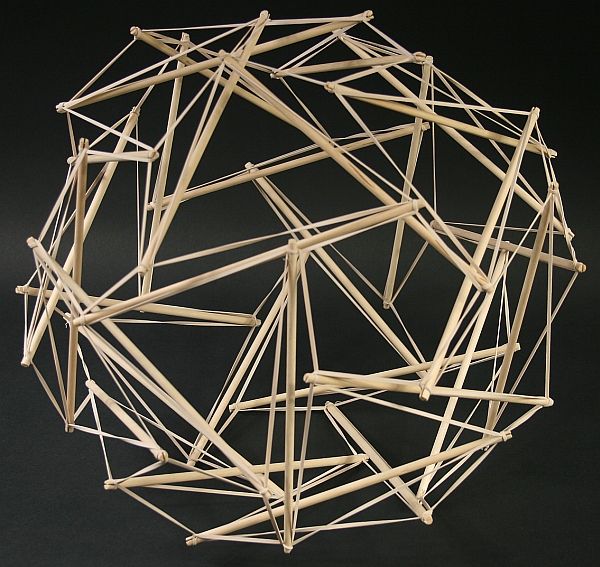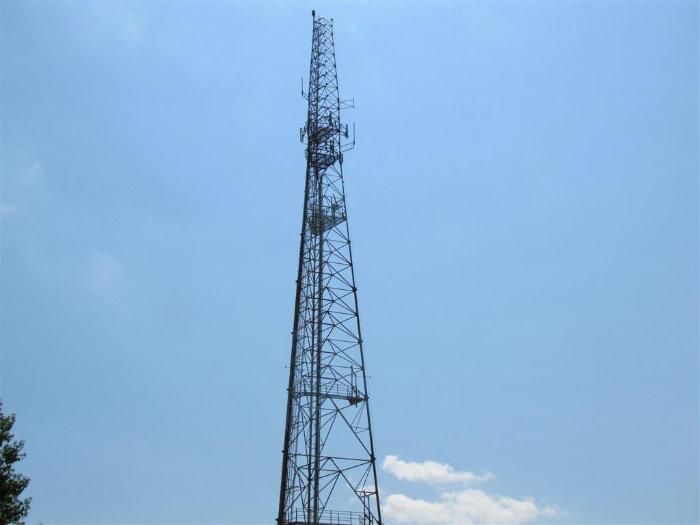Tensegrity describes a type of architectural structure developed by Buckminster Fuller. He also designed the geodesic dome. A radio tower with guy wires and all the triangles is a good every day example of a tensegrity structure - the tension of the cables holds it together. The body conforms to such a description with the muscles, tendons, and fascia keeping tension between the bones and allowing the body to move.
Not quite. The distinguishing factor of a tensigrity structure is that it's composed of rigid components under compression and flexible components under tension which is able to stand against gravity even though the rigid components are not stacked or
even in contact with each other.
In contrast, in a normal structure the resistance to gravity is ultimately provided by rigid components which are stacked, like blocks one on top of another. Each block supports the collective weight of the blocks above it. A radio tower falls into this category. It's held upright against gravity by stacked rigid components. The guy wires and the triangles are to add lateral stability.
A conventional structure can, of course, have components which are not supported from underneath and are held up by other components under tension. A suspension bridge would be an obvious example. However this is still not a tensegrity structure because the ultimate support for the cables under tension comes from the rigid components which are stacked against gravity.
The human body is, at least to a first approximation, a conventional structure. Support against gravity is provided by rigid components which are stacked one on top of another. The bones of the skeleton aren't shaped to enable the perfect alignment which would allow them to stay balanced upright by themselves, so the muscles have to provide a degree of tension which keeps them in that upright alignment. The more centered and upright the posture is, the less the muscles have to work to do that job.
The body is clearly not a pure tensegrity structure, however a theory is that the complex of muscles, bones, and connective tissues in the body's core (hips, spine, ribs, shoulders) may, if engaged and aligned properly, provide some degree of tensegrity support so that not as much weight is directly loaded through compression down from each vertebra into the disk and the vertebra directly beneath it. I'm not aware of any scientific studies to back up this idea. I do know that by being aware of properly engaging the deep muscles of my core I can produce the feeling that my spine is decompressing and the vertebrae are almost floating. However this sensation is not necessarily an accurate depiction of what is going on anatomically.
Basically the idea is that without some kind of tension the body isn't able to move.
Absolutely correct.
There are multiple types of muscle contraction - concentric the kind you describe that will lock the whole body down requires a lot of conditioning to use repeatedly. The next most are familiar with is isometric - that asshat in high school who could hold a dumb bell out forever. In Chinese systems the idea is that once you can relax the large muscle chains as much as possible you keep muscles responsible for keeping posture erect like the erector spinae in isometric contraction to remove slack from the torso and create a verticality in the body. Zhan zhuang or standing still is often the training method used for this. The art of Yiquan is based on this method.
Then one trains eccentric contraction in the body through pairing, the three exteranal alignments (hip and shoulder first one above the other and then opposite sides, the elbows and knee, same progression, hands and feet, same progression), slow movement, and intent. The feeling is more akin to wringing out a rag and will actually elongate the muscle. This also creates a feeling of effortless "no muscle" strength that is greater in effect than normal concentric contraction.
I think there might be some confusion about the terms here.
From the viewpoint of an individual muscle fiber, it know how to do only two things. It can contract (i.e. shorten or attempt to) or it can stop contracting. There is no signal a nerve can send to a muscle fiber which will tell it to expand and grow longer.
That's an individual muscle fiber. A muscle group (such as the bicep or the quadriceps) is made up of many individual muscle fibers, so it can contract with greater or lesser force depending on how many of its component fibers get the signal to fire.
Concentric contraction occurs when the force exerted by the muscle trying to shorten is sufficient to overcome any opposing forces.
Isometric contraction occurs when the force exerted by the muscle trying to shorten is exactly balanced out by opposing forces (such as gravity or other muscles) so that the muscle is not able to change length.
Eccentric contraction occurs when the muscle is attempting to shorten, but the opposing forces are greater than the force applied by the muscle, so that the muscle is stretched out despite its efforts to resist.
When you perform an "isometric contraction" (holding a dumbbell out in your example), your motor cortex isn't sending a message to your muscles saying "keep still". Rather it's sending messages telling certain fibers to pull and shorten - but calibrating those messages so that the net force created by the muscles trying to shorten exactly balances out the force of gravity trying to pull the dumbbell down.
When you perform an "eccentric contraction" (let's say lowering that dumbbell carefully back in the rack), your motor cortex isn't telling your muscles "lengthen". It's still sending messages to fibers in your bicep saying "shorten, contract", but it's sending just enough of those messages carefully timed so that the net force generated is enough to slow the dumbbell down as its weight stretches out your arm.
It's really an amazingly complex process and most of it is beyond the capacity of the conscious mind to directly perceive. Our conscious mind is like an chief executive in his office giving strategic directions (stand on one leg!, grab that box off the shelf!) while sub-processes in the sensory and motor centers of the brain take care of the details of implementation. It's no wonder that practitioners of different body movement systems (including martial arts) have developed a vocabulary for describing their process based on what it feels like rather than what is actually happening from a scientific perspective. Knowing what the movement should feel like is generally more useful for the practitioner than knowing the analytic details of what is happening at a biochemical level.
Movement is processed in the spine and while the spine is a signaling pathway to lower parts of the brain it is also responsible for localized processing. A recent study also shows long branch neurons help coordinate and handle localized and networked processing for cross body and limb movement.
Spinal cord processes information just like areas of the brain
Walking is bound hand and foot: How long projecting neurons couple the movement of our limbs | University of Basel
Cool. I was under the impression that any processing going on in the spinal cord was limited to a small subset of mostly hardwired reflexes, i.e. jerking your hand back from a hot stove or certain sub-processes related to gait or posture. It would be interesting to discover if there are more trainable patterns and circuits which can be developed. The linked articles don't have much to say on the topic, but I'll keep my eyes open for new information.



